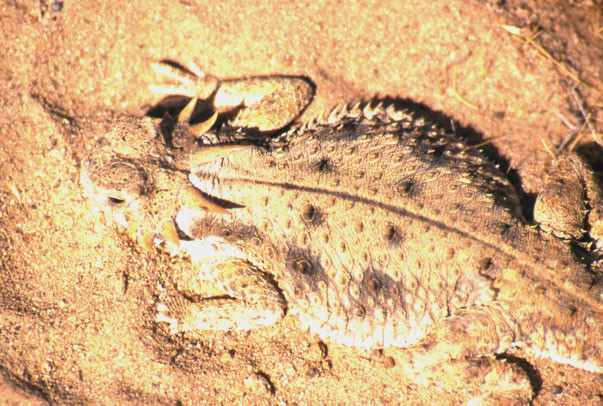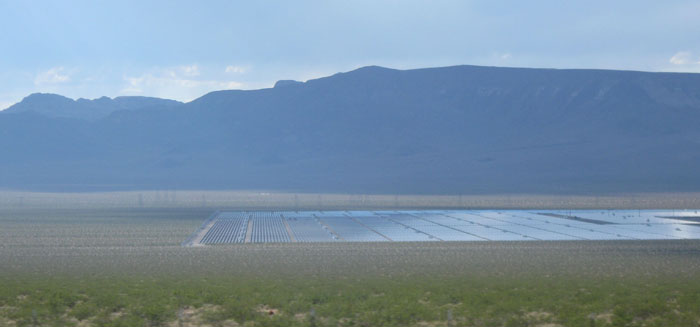Solar Energy Threatens California Desert

Dear Colleagues,
I am writing to urge you to oppose the development of central station, utility-scale solar energy installations remotely placed in the western deserts. The utility-scale solar energy projects proposed for the California Desert and adjacent areas of Nevada and Arizona will have massive and destructive footprints on the landscape. This development, touted by many politicians, environmental organizations, and state energy officials as "green energy," a term having benign connotations, is being justified in order to meet California's goals of AB 32 greenhouse gas emissions reduction and a Renewable Portfolio Standard (RPS) of 33% by year 2020. Ultimately, a cumulative area the size of Rhode Island, about 1,200 square miles of desert land could be destroyed in California alone. As of January 2010, the Bureau of Land Management had received more than 150 applications for large-scale solar projects on 1.8 million acres of federal land in six western states.
In nearly every case familiar to me, the proposed projects will impact threatened and endangered species, kill and displace wildlife, and permanently disfigure desert landscapes. Furthermore, the December deadline to qualify for stimulus dollars under the American Recovery and Reinvestment Act (ARRA) has created a rushed and chaotic process of review to approve the "fast-tracked" projects. In my opinion, adequate and proper scientific review has been seriously compromised.
The Chuckwalla Valley west of Blythe, an area rich in biological, archaeological, and aesthetic resources and certainly qualifying for national park status is threatened by dozens of renewable energy projects. There is tremendous pressure to develop the Chuckwalla Valley due to its proximity to transmission lines that feed into Los Angeles and Phoenix, but approval of these projects would be a tragic loss for wildlife conservation. The valley supports an array of unique, rare, and sensitive species, including the desert pupfish, Alverson's pincushion cactus, and the desert tortoise, a federally threatened species, to name a few. Chuckwalla Valley supports one of the finest stands of ironwood trees in the entire Sonoran Desert region. Some trees were growing along the McCoy Wash before Christopher Columbus landed in America. They have survived the hottest climatic periods and droughts in recorded history and prehistory, but they will not stand against the bulldozer.

^Desert ironwood (Olneya tesota) blooms.
In the Imperial Valley, another project will destroy foraging habitat for the peninsular desert bighorn sheep, a federally endangered species, and habitat for the flat-tailed horned lizard, a candidate for threatened species. Thousands of these lizards, other reptiles, and small mammals will be killed or displaced during project construction, including sensitive species such as the kit fox, badger, burrowing owl, and golden eagle. The aesthetics of the Anza Trail, managed by the National Park Service, will be impacted, and Native American cultural resources, including sacred sites, will be lost as well.

^Flat-tailed horned lizard (Phrynosoma mcallii).
What is the alternative to placing these massive projects on pristine desert land? The most environmentally friendly option for site placement would be the unused rooftops of homes and office buildings that can be used for distributed photovoltaic energy generation. There are thousands of acres of rooftops in Albuquerque, Las Vegas, Los Angeles, Phoenix and Salt Lake City. There would be no need to transport electricity from remote sites in the desert along transmission lines, thereby avoiding loss of efficiency. It can be argued that this is the low-cost, high-value way for California to achieve its goal of 33 percent renewable energy use by 2020. Also, promoting roof top installations would create a growth industry, a much needed boost for our failing economy.
If utility scale solar installations are to be built, the use of "brownfields," e.g. decommissioned landfills, abandoned mines, and other degraded lands would avert needless habitat destruction. The use of "brownfields" for renewable energy development has been supported by the Environmental Protection Agency since 2003. According to the EPA, at least 11,000 sites exist nationwide that are suitable for this purpose. Such blighted real estate, which constitutes a liability to state, county, and local governments, should be reclaimed in this innovative way. It would be a win-win outcome for energy development and environmental protection. Another option is converting fallow agricultural land for solar collection, as private landowners in many areas are willing to sell their acreage.
Many projects are being "fast-tracked" so that they can meet the December deadline to qualify for ARRA stimulus dollars. The industry stands to make billions of dollars and temporary jobs will be created, but in the end significant parts of our natural heritage will be lost forever. A California Energy Commission (CEC) memorandum dated July 27, 2010, admits to lacking solar component endurance and reliability data for the Imperial Valley project, yet the CEC is willing to sacrifice biological, cultural, and aesthetic resources as part of a trial and error process of solar energy development. This reveals an appalling lack of environmental concern, and project approval would be an outrageous abridgement of due process and prudence.
Humanity is losing its connections to the natural world and we are inexorably destroying it day by day, piece by piece. The short-lived economies realized by developing pristine desert lands will be quickly eclipsed by the incalculable and irreparable damage to the biota and landscape of California, the heritage of our future generations. Do we, as a society, place any value on other life forms, or do we destroy them simply because it is expedient to do so? Bulldozing plants and animals into oblivion and defacing pristine desert landscapes is a horribly misguided path to our energy future. Ironically, the "green energy movement" now being promoted could well become one of the most environmentally destructive periods in our nation's history.
I am asking for your help. Please write to your representatives in Congress about the negative ecological impacts of utility-scale solar energy plants. Suggest distributed photovoltaic energy development as an environmentally sound and economically wise alternative. Also, a resolution of scientific guidelines for large-scale solar projects submitted by the Ecological Society of America might persuade the Obama Administration to take a better approach to renewable energy development. Currently, the administration and Congress claim to be following scientific recommendations, but instead may be responding to lobbying pressures from big solar companies.
Sincerely,
Richard R. Montanucci, PhD
Associate Professor Emeritus
Deptartment of Biological Sciences
132 Long Hall
Clemson University
Clemson, SC 29634-0314 USA
^Copper Mountain thin-film photovoltaic plant in the Nevada desert.
HOME.....Solar Done Right.....Chuckwalla Valley.....Imperial Valley

